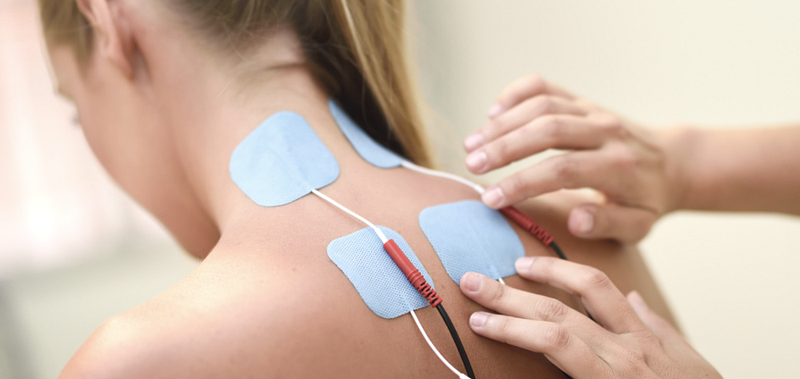TENS, or transcutaneous electrical nerve stimulation, is a pain treatment that uses low voltage electric current to Distract pain signals in your body. TENS is typically done with a TENS unit.
Nowadays there are many types of TENS Modalities are available, but the basic principle remains the same. TENS can be portable or with a clinic setup.
You attach the pads directly to your skin. When the machine is switched on, small electrical impulses are delivered to the affected area of your body, which you feel like a tingling sensation.
The electrical impulses can reduce the pain signals going to the spinal cord and brain, which may help relieve pain and relax muscles. They may also stimulate the production of endorphins, which are the body’s natural painkillers.
There are two theories about how transcutaneous electrical nerve stimulation (TENS) works.
One theory is that the electric current stimulates nerve cells that block the transmission of pain signals, modifying your perception of pain.
The other theory is that nerve stimulation raises the level of endorphins, which are the body’s natural pain-killing chemicals. The endorphins then block the perception of pain. but in short, it is all about Pain gate Theory! :)
Types OF TENS
- High-Frequency TENS ( Conventional TENS)
- Low-Frequency TENS (Acupuncture TENS)
- Burst TENS
- Brief Intense TENS
- Modulated TENS
Where TENS is USED ?!
TENS may be able to help reduce pain and muscle spasms caused by a wide range of conditions including arthritis, period pain, pelvic pain caused by endometriosis, knee pain, neck pain, back pain, sports injuries and It’s also sometimes used as a method of pain relief during labor.
TENS is a non-invasive method for relieving pain. People who experience pain relief from TENS may be able to reduce their intake of pain medications. A physiotherapist is Using TENS for a long time and it is showing both Physical and psychological effects.
yet some evidence is showing that TENS is not effective in all conditions.

Why TENS Doesn’t Tone
Although electrical impulses are used by TENS units, they don’t stimulate the right muscle contraction neurons. According to the Principles of TENS, they stimulate sensory neurons which send pain signals to the brain, confusing and negating the pain signals.
They also promote endorphin release, which can help to eliminate pain in the muscles. Sensory neurons are one of three types of neurons that make up the human body.
Interneurons, which run through your brain and spinal cord and facilitate neuron-to-neuron communication, send signals to your body. Interneurons in the spinal cord communicate with motor neurons that control muscle contraction.
This is how you consciously move your muscles while exercising, unconsciously maintain your balance, or jump back involuntarily in response to an unexpected stimulus. The motor neurons are directly targeted by EMS, bypassing the interneurons entirely.
That means it can deliver more contractions per minute and for longer periods of time than you could consciously perform. The muscle tissue is built faster by more and longer muscle fiber contractions than through a traditional workout.
Although TENS units do not directly tone your muscles, they can help you grow muscles faster in the long run. Although the pulse sent will not fully contract your muscle, it can aid in the relaxation of knots and the relief of muscle pain. This could help you improve your workout performance and, as a result, tone your muscles more quickly.
When to avoid TENS?

Although it is safe for most people, Physiotherapist Recommend that people who are contraindicated like Pregnant women, epileptic or people who are getting seizures infrequent, People with heart problems or related to Blood pressure( hypertension or hypotension), and People with a pacemaker or another type of electrical or metal implant.
TENS should not be applied To infected tissues, wounds due to osteomyelitis, or if you have tuberculosis.
TENS therapy may result in the spread of infections. and To areas of tissue that have been recently treated with radiation. So basically cancer is also contraindicative.
TENS should never be applied on Near or over eyes or mouth, front or side of neck, or on the head, Near reproductive organs or genitals. a patient who has to severe lack of sensation is also contraindicative.
I have seen people using Portable TENS while bathing and showering, which is very dangerous, so never use it while this. even people should be awake all the time, so if any changes to electrical pulse can be identified earlier to prevent any skin damage, so many times the patient gets asleep during so soothing experience of TENS, which is not good.
What is the Adaptation of TENS?
people who use a TENS unit daily at the same frequency and intensity can develop a tolerance or in simple language adaptation to the treatment.
It may appear that using EMS to tone muscle is a painless way to gain muscle, but it isn’t. After experiencing pain caused by the treatment, athletes who have full sensory perception can often be dissuaded from engaging in a regular EMS training program.
This is because waveforms activate neurons in the brain that carry pain signals and other sensory information.

A person who develops tolerance will no longer feel the same level of pain relief that they did when they first used the unit.
To prevent this from occurring, people can alternate between Low Frequency and High-Frequency TENS within each treatment session. Alternatively, they can gradually increase the intensity or duration of TENS daily.
Where to place Electrodes of TENS?
Tender Point, the answer is tender Point or acupuncture points. majorly Physiotherapists working or practicing, are using tender points to place the electrodes. it is a totally different technique than IFT.

“It is like your Physiotherapist knows Electrotherapy better then your Google knowledge”
So ask before you place TENS on your Body, as it is an electrical modality and use without precautions may cause serious harm to your body.
Can a TENS unit build muscle?
The brief answer to the question, then, is no. TENS cannot be used to build muscle because it does not cause a complete muscle contraction. However, the therapy is effective in treating pain, releasing muscle knots, and improving athletic training sessions in a therapeutic capacity.
However, electrical muscle stimulation may be possible. TENS is better for pain relief, whereas EMS has been shown to help with muscle development and rehabilitation, though more research is needed.


Comments
Post a Comment